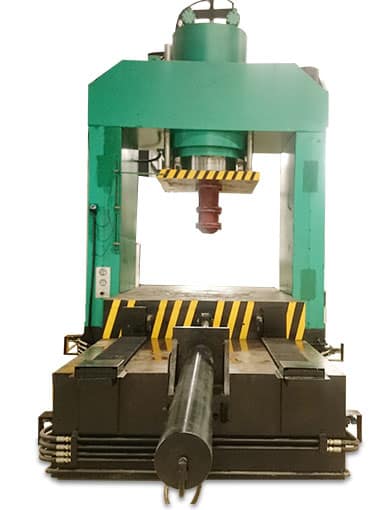How Do Hydraulic Presses Work?
time:2023-08-31 views:(点击 1,151 次)Hydraulic presses are capable of creating enormous forces, making them ideal for various industrial uses. But how exactly do these powerful machines function?
Hydraulic fluid is used to generate and transfer force between two pistons of different sizes, using pipes and cylinders, with a pump used to pressurize it.
Piston Area
Area of Piston in Hydraulic Press Application The piston area plays an essential part in determining how much force a hydraulic press can apply, as its surface area determines how much pressure can be generated quickly by it and also how rapidly that pressure builds up. A larger piston can handle more pressure due to having more surface area. Likewise, force of pressure depends upon both diameter and radius size of piston.
To determine the area of a piston, it's necessary to understand its working pressure in pounds per square inch (psi). You can then use this number as an estimate of force produced by its piston. To measure pressure accurately, divide the cylinder's bore diameter by 2 and square it before calculating piston area based on pi x r2.
When using a hydraulic press, it's essential that both piston area and rod end load cells are aligned so they measure equal forces, giving you more accurate readings and eliminating errors from occurring in results. Furthermore, you should ensure your limit switch is adjusted properly so as to prevent too much pressure being applied - which may otherwise damage material or lead to injuries among workers.
Hydraulic systems have long been recognized as powerful force multipliers due to their ability to convert small amounts of force into significant ones. Hydraulic systems work this way by sending massive amounts of pressure through tortuous channels at once - thus making hydraulic jacks suitable for lifting objects that would be too difficult or impossible for an ordinary human being to lift by hand.
Hydraulic presses can be utilized in numerous applications, from forging and clinching to molding, blanking, punching and deep drawing. They're particularly effective at jobs requiring high degrees of precision and accuracy - such as manufacturing aerospace components or automotive parts with precise control that ensures quality products at cost-effective rates while still protecting employees' safety. Hydraulic presses have proven particularly popular as manufacturing tools because of their flexibility in producing precise parts without compromise to employee health or safety.
Piston Diameter
A hydraulic press uses a hydraulic cylinder to generate pressure. This metallic pipe-like device contains ports for the input and output of hydraulic fluid, with pistons moving in and out of it as needed to convert fluid power to mechanical force by pushing on its piston. The size of its piston determines its ability to exert force - smaller diameter pistons create larger force output, which allows smaller pistons to move larger ones with minimal effort. This phenomenon is known as force multiplication; as such it explains why smaller pistons can move heavier ones more efficiently than their larger counterparts.
A hydraulic press serves multiple functions, from flattening metal and installing bearings to making swords and punching holes in metal plates. Additionally, its squeeze function makes crushing materials too hard for manual pressure easier than ever - thus it is important that its workings be understood to maximize its use properly.
Pascal's Law dictates that small pistons can create large amounts of force by exerting small pressure against them and applying Pascal's Law; which states that pressure in liquid is equal to force exerted on an area. So by exerting even small pressure onto your piston, its force multiplies to create significant load pressure on its load.
There are various types of hydraulic presses, each offering their own advantages and disadvantages. Some models are portable for easier movement while others provide greater pressure ranges. When selecting the appropriate press type for you needs it is vital that you consult the manual first to operate successfully.
There are other tools available that can also create high amounts of pressure and force, like belt-apparatus that produce 1500 pounds per square inch - enough to break nearly anything! While powerful, such instruments may be difficult to control.
Hydraulic presses are ideal for industrial production as they are easy to control and deliver precise pressure output. Furthermore, these devices can lower noise levels by as much as 60% - an invaluable benefit in factories where employees are subjected to prolonged noise exposure.
Cylinder Pressure
Hydraulic presses play an integral part of many production processes, from shaping metal and creating machine components, to crushing waste, compacting waste, or compressing it. They use Pascal's principle and use static pressure in liquid to generate massive force; from small tabletop models all the way through massive machines that exert hundreds of tons of force - there is a hydraulic press suitable for almost any task or need.
An essential component of any hydraulic system is a pump, which feeds oil to a cylinder before pressurizing and pushing against another cylinder with piston force. The resultant force may be up to 20 times greater than what is applied by users, making hydraulics ideal for applications requiring high levels of force.
Hydraulic presses serve multiple functions in the manufacturing industry, from shaping and configuring automobile parts to testing the tensile strength of concrete. Furthermore, hydraulic presses can compress powdered materials into various shapes, designs, and densities - an indispensable tool in various fields ranging from mining and construction to electronics production.
From their simple designs to complex power systems, hydraulic presses offer several features that make them popular choices for industrial applications. Perhaps their most impressive benefit lies in their consistent force production throughout each pressing stroke; this reduces costs while increasing machine efficiency.
Hydraulic presses are designed to be quieter than mechanical ones, which helps decrease noise pollution as well as employee fatigue and illness risk. Their precise control also helps prevent damage to equipment or material during operation.
Hydraulic presses may be more expensive than mechanical presses, but they have several advantages over their counterparts. Hydraulic presses are better at handling large quantities of material at once and more versatile than other forms of machinery - they can shape and deform materials including metal and plastic with relative ease, punch or shear metal to form different shapes depending on their application, etc.
Cylinder Area
Hydraulic presses can be utilized for an assortment of industrial processes, from metal forming and car crushing to glass thinning and thin film laminating. Their operation relies on Pascal's Principle, which states that pressure applied to any fluid body will be distributed equally across its volume allowing a relatively smaller cylinder to move a much larger one.
Hydraulic presses are powered by hydraulic pumps. Each pump creates a fixed pressure known as tonnage that determines its force of application. Furthermore, these pumps supply high-pressure working fluid to hydraulic cylinders - these in turn compress anvils and dies.
Calculating force in a hydraulic press requires knowing three variables - size of piston, its diameter and area of cylinder. Diameter can be determined by measuring from center of cylinder to edge distance while area can be calculated by multiplying piston diameter by Pi (pr2).
Hydraulic cylinders are metallic tubes equipped with two ports used to input and output hydraulic fluid. Their sizes depend on your application and size of hydraulic press; typically measured in pounds per square inch or PSI, their working pressure must also be known in order to calculate force accurately. Cross-sectional area calculations for hydraulic cylinders can be determined by dividing diameter by radius before multiplying this figure with pressure for an estimate of piston force.
XRF Scientific provides laboratory equipment such as a hydraulic tool for sample preparation for X-ray fluorescence (XRF). This is an excellent way to quickly and accurately prepare samples for analysis, with adjustable speeds, forces, directions and pressure settings that enable you to prepare any type of sample for analysis by the machine. Operation is easy while it allows a variety of tests to be run concurrently.
Link to this article: https://www.ihydraulicpress.com/nsn/4558.html
Hot Articles
-
How to Make a Homemade Hydraulic Press
Hydraulic presses play an integral role in many metalworking processes, from shaping machine components to compacting waste material. They offer v……
-
How to Make a Hydraulic Press With Syringes
Hydraulic systems have many industrial uses, from car lifts and jacks to providing help on farms for various tasks. This project provides an easy ……
-
How to Make Rosin With a Hydraulic Press
Rosin is a solvent-free extract of cannabis that’s popular among dabbing enthusiasts. Producing Rosin requires only basic equipment for prod……
-
How to Make a Homemade Hydraulic Press
Hydraulic presses can be an incredibly useful tool, yet their potential to crush, break and destroy materials should not be underestimated. DIY-er……
-
How Much Pressure Should a Hydraulic Press Have?
Pounds per square inch (psi) is used to measure the force exerted by a hydraulic press, following Pascal’s Law that states any force exerted……
-
How to Make a Hydraulic Forging Press
Forging is the process of shaping metal with mechanical or hydraulic force. While some forging machines use mechanical pressure, others utilize hy……
-
Hydraulic Press Channel
Lauri Vuohensilta of Finland has become an internet phenomenon since 2015 with his captivating videos that demonstrate him using a hydraulic press t……
-
How to Make a Mini Hydraulic Press Machine
An hydraulic press can be an invaluable asset to any master who works from home. Building one yourself may take more time than renting or buying one……
Latest News
-
How to Make a 150 Ton Hydraulic Press
A 150 ton hydraulic press is a heavy-duty machine used for metal pressing and stamping applications. Constructed of durable steel material, its st……
-
What Can I Make With a Hydraulic Press?
Hydraulic presses are indispensable tools in nearly all large scale industries and workshops often boast their own c-frame hydraulic press for use……
-
How to Make Hydraulic Press Plates
Hydraulic presses use immense forces to compact different materials together, with platen presses being the most popular form due to their reduced……
-
How to Make a Hydraulic Press for Knife Making
A hydraulic press can expand what can be accomplished with hot metal. It allows you to perform many of the same operations as with power hammers but……
-
How to Make an Electric Hydraulic Press
An electric hydraulic press is an invaluable tool for compacting materials. Junkyards often utilize this piece of equipment to crush cars, machine……
-
How to Make a Coin Using a Hydraulic Press
There are various kinds of hydraulic presses, yet all work similarly. Their primary function is powered by hydraulic pumps which generate pressure……
-
Can You Make Manual Press Into Hydraulic Press?
Hydraulic presses are widely utilized across industries for cutting, clinching, moulding, punching, deep drawing and metal forming operations. Compa……
-
How to Make Manual Hydraulic Press
Hydraulic presses are widely utilized across numerous industries for fabrication, assembly and maintenance tasks. Their pressure generated by pump……














































